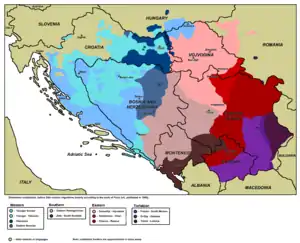Prizren-Timok dialect
The Prizren-Timok dialect (Serbo-Croatian: Призренско–тимочки дијалекат / prizrensko–timočki dijalekat) is the name given by Serbian linguists to a specific part of Shtokavian dialects, spoken in Eastern and South Serbia and Kosovo[lower-alpha 1]; an area spanning from Prizren in the south to the Timok River in the north. Its eastern border, starting from Zaječar, roughly forms the border with Bulgaria.

Map of Shtokavian sub-dialects, according to Pavle Ivić (1988 book). The Prizren-Timok dialects are shown in three colours in the southeastern corner.
Sub-dialects
- Prizren–South Morava (Призренско–јужноморавски / Prizrensko–južnomoravski)
- Svrljig–Zaplanje (Сврљишко–заплањски / Svrljiško–zaplanjski)
- Timok–Lužnica (Тимочко–лужнички / Timočko–lužnički)
- Pirot (Пиротски / Pirotski)
- Crna Trava (Црнотравски / Crnotravski)
- Lužnica (Лижнички / Lužnički)
See also
Notes
- Kosovo is the subject of a territorial dispute between the Republic of Kosovo and the Republic of Serbia. The Republic of Kosovo unilaterally declared independence on 17 February 2008. Serbia continues to claim it as part of its own sovereign territory. The two governments began to normalise relations in 2013, as part of the 2013 Brussels Agreement. Kosovo is currently recognized as an independent state by 98 out of the 193 United Nations member states. In total, 113 UN member states recognized Kosovo at some point, of which 15 later withdrew their recognition.
References
- Ethnologia Balkanica. 12. Lit Verlag. 2008. p. 157.
The Vranje speech belongs to the Prizren-South Morava type in the Prizren-Timok dialect zone (Ivic 1985: 115-118)
Further reading
- Динић, Јакша. Тимочки дијалекатски речник. Vol. 4. Ин-т за српски језик САНУ, 2008.
This article is issued from Wikipedia. The text is licensed under Creative Commons - Attribution - Sharealike. Additional terms may apply for the media files.